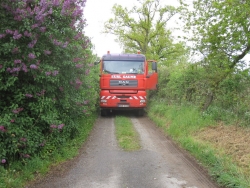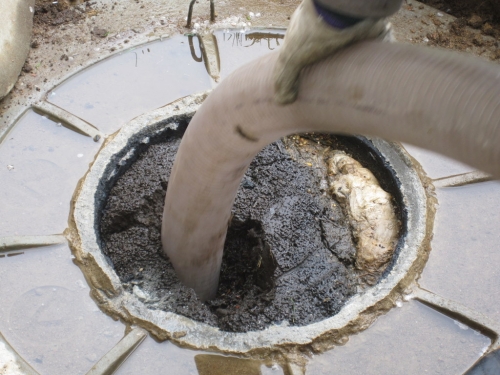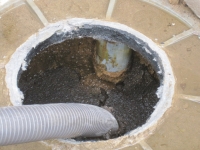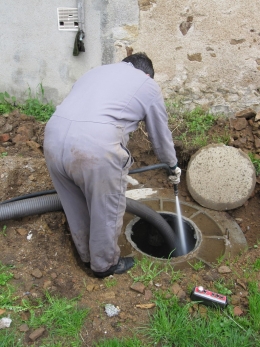Friday came, and eventually (only two hours late) so did Monsieur Gaume.
We had the usual mobile phone call to enquire how exactly to find our isolated house, and then his huge red lorry squeezed down the lane.Turning round seemed likely to prove a major problem, solved by removing a section of fencing so that he could tentatively reverse into the cow field opposite. He then backed the truck down the lane to get as near as possible to the septic tank.M Gaume was a man of few words, but undoubted skill and experience. In a few minutes, he had a large hose assembled and stretched out from the lorry to the hole. Without hesitation, he chipped through the cement and levered up the top off the tank.
His only comment on what was revealed was “Ah, c’est bien pleine” (“It’s very full”). I didn’t respond, being rather speechless at the sight of a thick crust of decades-old digested shit. My jaw dropped further as he stabbed into it with the large hose, and pressed a button on a remote control unit. What sounded like a jet engine roared in the depths of the truck, and massive suction instantly started to pull the brown mass up the hose.
I reckon that 1000 litres of semi-solid sewage must weigh well over a ton. It seemed to me that this all disappeared into the lorry in a matter of seconds.
Perhaps not surprisingly, the material under the solidified crust was less attractive and more odorous – and I suggest you consider carefully whether you want to click on the picture on the left for an enlarged version!It turned out that the tank had the two chambers found on a modern tank, and so a second suction session was needed.
Each session concluded with extremely powerful flushing and rinsing with fresh water (initiated by another button on the remote control). An almost spotless tank was revealed in a few minutes, and its functioning was verified by some celebratory flushes of the toilet.
Within a few more minutes, M Gaume had taken my cheque, completed the numerous bits of paperwork always required by French bureaucracy, and given me the necessary certificate so I can prove to an inspector that the required maintenance has been completed. Before he departed, he told me that we should not need to repeat the operation for three or four years.
Brilliant! I’ve just had a long shower, rejoicing in the gurgling that accompanies the rapid disappearance of the water. Val has run the washing machine, and we have both marvelled at the near-silent smooth flushing of the toilet. The small pleasures are the best ones . . . . .











I bet Val is really really really pleased that she can go inside and also have a shower at long last….:-)
“The small pleasures are the best ones . . . . .”-that si so ture. Bet that is a really satisfying job if you have no sense of smell!
or even “is so true!”
I fully understand this pleasure! We can now flush our toilet into our brand new fosse rather than into a field, but have been hampered by the fact that our Fosse man Warren has not finished the filter bed due to a variety of excuses such as there is a Y in the day..and a marital crisis halfway through the job! One more flush and our fosse will overflow!
Good old Monsieur Gaume! I’m glad that was accomplished so smoothly 😀
What a job, though.
…..we have been told by the company that I contacted, re F.S emptying, that we have to remove the cap ourselves – is this usual?? It seems very firmly stuck down with cement – haardly what two OAPs want to be wrestling with. Any advice out there?
Ours was also stuck down. The man who arrived to do the emptying made a ‘Tsk’ noise, and said “Oh it’s stuck down!”. Then he went back to his lorry, fetched a hammer and chisel, and removed it in about 10 seconds! Obviously, he was used to finding this situation.
I would have expected your firm to do the same. Mind you, he didn’t cement it back into place after the emptying. In our case, this did not matter at all, as the cement seemed to be only necessary for holding it in place while earth was being put over it again. If yours is underground, I guess the same would be true. If the cap is on the surface, then applying a little mortar (bought ready mixed from a DIY store) to make a seal should be possible?
Good luck!